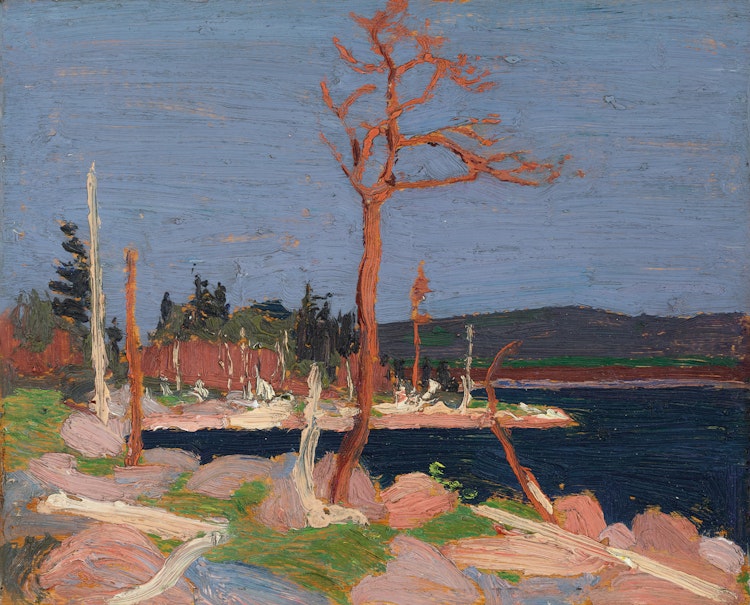Nocturne by Tom Thomson

Tom Thomson
Nocturne
oil on panel
estate stamp lower left; titled, dated 1916, estate stamp and inscribed “Beatrice” on the reverse; catalogue raisonné no. 1916.82
8.25 x 10.5 ins ( 21 x 26.7 cms )
Auction Estimate: $900,000.00 - $1,200,000.00
Price Realized $1,500,000.00
Sale date: June 15th 2022
Estate of the artist
W.J. Alexander, Toronto
Gift to Laura Beatrice Wheeler, Toronto
Edith Alexander MacIver, Toronto
Estate of Edith and Keith MacIver, Toronto
Sotheby's Toronto, 17 May 1989, no. 34
Private Collection, Montreal
The Allens, Montreal
Masters Gallery, Calgary
Private Collection, Calgary
Mayberry Fine Art, Winnipeg
Private Collection
Joan Murray (researched and written by), “Tom Thomson Catalogue Raisonné” [online publication], entry 2016.82 (https://www.tomthomsoncatalogue.org/catalogue/entry.php?id=524), reproduced
Richard Rhodes, ‘Paddle: The Letter’, “Canadian Art”, Vol. 13, No. 3 (Fall 1996), reproduced page 107
Joan Murray, “Tom Thomson: Trees, Toronto”, 1999, reproduced pages 86–87
Susan Walker, ‘$135,000 That’s What this Painting Fetched at Auction Yesterday. (Unfortunately, the Seller Had Paid $165,000 for It.)’, “Toronto Star”, 21 February 2000, reproduced
Thomson probably painted “Nocturne” one evening while fire-ranging at Achray, then a park station on the northern shore of Grand Lake, part of the Barron River system in Algonquin Park. He had spent the winter of 1916 in Toronto and arrived in Algonquin Park as was his habit in March. In April or early May, Thomson had a visit from his friends Lawren Harris, Harris’s cousin Chester Harris and Dr. MacCallum, intent on a fishing trip. Late in May and until August, Thomson took a job as a fire-ranger, reporting to Achray. Then he and another friend, Edward Godin, who had worked at Achray with him, went on a canoe trip down the south branch of the Petawawa River, then up the north branch to Lake Traverse. In late October or early November, he returned to Toronto.
All that spring, summer and fall, Thomson painted. Among his many sketches, he was particularly inspired by trees in different configurations, such as that spring, when he painted the sketches for “The Jack Pine” and “The West Wind”. He was inspired as well in 1915 to 1916 by nocturnes, often strongly-designed. He must have liked the sometimes muted, sometimes gorgeous colours nocturnes inspired as we find in this Nocturne, in the colour of the surf on the distant shoreline, which forms an unruly line of purple and blue. During the winter of 1915-1916, he even essayed one canvas from a sketch, and it turned out well. Naturally he called it “Nocturne”. Such paintings formed a background to this beautiful painting. After it, he painted one more twilight scene as well as continuing to paint many tree studies.
Here, he focused on the subtle effect of early twilight on trees and shore. He may have intended the work as a simple exercise but its design sets it apart in his body of work as one of the more striking expressions of his art and a more than successful result in his painting of landscape. “Nocturne” is an ode to Algonquin Park and the inspiration he was finding in the north. It also is one of the rare examples by Thomson or later, by his artist friends who founded the Group of Seven, of a painting done during the summer when greens, which they professed to dislike, prevailed.
“Nocturne” has a long and distinguished pedigree. Initially purchased by W.J. Alexander, the first professor of English at the University of Toronto, and later given to a “Beatrice” (the name inscribed on the back of the sketch), probably Laura Beatrice Wheeler. It was owned by Edith MacIver, the wife of Keith MacIver, a former prospector, who - after Thomson died – lived in Thomson’s “Shack” situated next to the Studio Building in Toronto.
We extend our thanks to Joan Murray, Canadian art historian, for contributing the preceding essay.
Share this item with your friends
Tom Thomson
(1877 - 1917)
Tom Thomson was born near Claremont, Ontario and grew up in Leith, near Owen Sound. After moving to Toronto, his early career was spent as a commercial artist at Grip Ltd., the commercial design firm where he first met MacDonald, Harris, Jackson, Lismer and others. By 1911, Thomson was making regular sketching trips to areas north of Toronto and, in 1912, he made the first of many trips to Algonquin Park.
As well as being an artist, Tom Thomson was an avid outdoorsman and Algonquin Park soon became his favourite place to paint. His enthusiasm for its quiet, untouched landscape with its changing moods and bright fall colours inspired other artists to explore the region. After 1914, Tom Thomson spent most of his time painting in Algonquin, except during the coldest winter months. It was during this period that he produced the bulk of his paintings of this rugged northern landscape. Thomson's brief, but prolific, career as an artist came to a premature end when he drowned in Canoe Lake in 1917, just three years before the Group of Seven held their first exhibition. His artistic achievement was to remain an inspirational force to other Group members.

